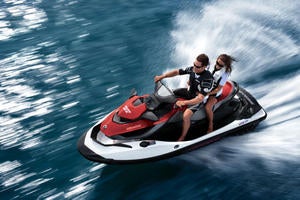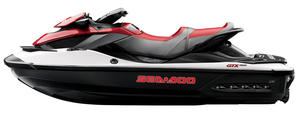2010 Sea-Doo GTX iS 215 Review
A more affordable suspension model
While much of Sea-Doo’s 2010 line seems to be focused on bringing the braking and electronic throttle control features introduced on last year’s high-end GTX iS Limited and RXT iS models farther down the family tree, one model, the GTX iS 215, is designed to bring that craft’s other big innovation — suspension — to a greater number of buyers.
Oh, the Suspense
Last year, suspension was reserved for the elite. This year, it’s made slightly more affordable to those who winced at the ’09 price tag, or just preferred a slightly tamer engine.
Sea-Doo accomplishes suspension by separating the upper deck (essentially the rider area) from the hull below. Seat, handlebars, even footwells are sprung above the hull via a twin-arm suspension, and cushioned by a center-mounted spring and shock absorber. The onboard computer determines the level of shock absorption when a rider first starts the boat and takes a seat. From there, the driver can go with the factory setting, or manually soften, or stiffen, the ride on a scale of 1-9. Total travel of the upper rider pod within the hull is a little less than six inches.
How does that translate to the on-water ride? Don’t expect to magically float atop the chop. It’s not going to happen. The suspension does, however, definitely soften the abuse of rough water, making it far more tolerable to cruise in the open ocean or a rough waterway. I’ve actually begun to appreciate the shock more and more as a driver, but a trip as a passenger ultimately sold me. Heading into a boat’s wakes without slowing, I was ready to curse my driver for the spine-jolting blows I was about to experience. Instead, we gently bounced over the waves with nary a jolt. It really works.
 The new hull is adept at holding a straight line no matter the water condition.
The new hull is adept at holding a straight line no matter the water condition.As does the new hull Sea-Doo introduced in 2009. Featuring a step that’s designed to reduce drag and improve cornering, it’s a far more big-water worthy boat than GTX hulls of the past. Yes, it’s bigger, by about 9 inches. But it’s also far more big-water worthy, holding a straight line no matter what waves are thrown its way and never getting swallowed up by the conditions.
It’s also more fun to ride. While the suspension design definitely results in a higher center of gravity, making low-speed maneuvering a little tippier than riders may be accustomed to, throw the machine into a corner and it carves a precise, hiccup-free line that almost begs the driver to push it farther. Like the XP models of old, you can actually feel the suspension slightly compress in hard corners, enhancing the rider’s feeling of control over the boat.
The Full Monty
 Squeeze the brake lever and the bucket drops to reduce your speed in a hurry.
Squeeze the brake lever and the bucket drops to reduce your speed in a hurry.The GTX is 215 also gives you the full complement of features introduced on 2009’s elite models. That means you’ll have braking. Wish to stop the craft and you can literally pull the brake lever, triggering a specially designed reverse/brake bucket that shifts down to disrupt the flow of water out of the jet nozzle and redirect it as necessary. Braking can slow the boat nearly 50-percent better than a non-brake-equipped craft. The craft’s computer brain keeps that braking force from being too aggressive, and riders can feather the handle just like a car brake to control the abruptness of the stop. It’s not the ultimate solution. Normal collision-avoidance style turns, or even the craft’s own off-throttle steering, will produce the quickest escape in really tight situations. For normal riding, however, it gives a driver a whole new dimension of control.
That brake, however, also allows the GTX iS 215 to behave more like a traditional boat. Start at the dock and the bucket shifts down over the nozzle to approximate neutral. Grab the left handlebar lever to reverse and it flips down all the way to allow you to back away; squeeze the right-hand throttle lever and you go forward as normal. I’ve noted riders learn the technique very quickly, as it’s almost completely intuitive. It also allows the driver to keep their eyes on the water, and hands on the handlebars.
More electronic goodies on hand include “intelligent” throttle, essentially cruise control for your boat. Drivers can select to keep their speed with the push of a button, then fully squeeze the throttle to eliminate the normal required finger pressure. Release the throttle and the craft returns to normal operation. Small adjustments can be made in 1mph increments. You also get no-wake mode, which keeps the boat moving anywhere from 1-7 mph for slow speed zones.
New this year is that the GTX will start up in a “touring” mode, which essentially remaps the acceleration curve to provide a slightly gentler ride. Drivers can opt out and select “sport” mode to gain the engine’s full powerband.
The new design also brings other extras along for the ride. The GTX’s nicely bolstered, touring-style heat is now hinged, and rises on a pneumatic strut, much like an automobile hood. That eliminates finding a spot to place the seat when doing routine maintenance. I also like how the info display tilts with the craft’s tilting handlebar. That way you always see it, rather than find your view blocked by the bar. There’s also a pop-open fuel fill that eliminates the former screw cap. Of course, Sea-Doo continues to offer the Learning Key lanyard system. It acts as a kill switch, theft-prevention device, and an additional lanyard also functions as a speed governor to slow the boat when desired.
Biggest drawback to the new design? I continue to argue it’s storage. At 16 gallons, it pales in comparison to the cavernous enclosures of Kawasaki and Yamaha.
Tastes Great, Less Filling
 Your passenger (and your back) will no doubt appreciate the suspension-equipped GTX iS 215.
Your passenger (and your back) will no doubt appreciate the suspension-equipped GTX iS 215.All this leaves the only real difference in the craft — its 215hp engine. Essentially it remains the same 1,494cc four-stroke that powers the line. Not so long ago, it was the king. A supercharger and intercooler boosts power to impressive levels. Acceleration is arm-wrenching in Sport mode, and top speed remains in the 65 mph range. So what’s the difference? It’s just a tad tamer than the now-260hp variation that tops the line.
That’s not a huge difference in many respects, but it does help the 215 come in at $14,699. That’s a few hundred dollars less than the race-oriented RXT iS 260, and nearly $2,000 less than the blinged-out iS 260 Limited.
Whether or not it’s the boat for you, well, that depends on how cushy you like your ride, and how rough your normal riding area tends to be. Ask your back…it probably has an opinion.
| Sea-Doo GTX iS 215 Specs | |
| Length | 139 inches |
| Beam | 48 inches |
| Dry Weight | 960 lbs |
| Engine | Three-cylinder EFI, Supercharged/Intercooled |
| Displacement | 1,494 cc |
| Bore and Stroke | 100mm x 63.4mm |
| Compression Ratio | 8.4:1 |
| Rated Horsepower | 215 |
| Fuel Capacity | 18.6 gal. |
| Combined Stowage Capacity | 16.4 gal. |
| Color | Autumn Red |
| Price | $14,699 |
Related Reading
2010 Sea-Doo GTX 155 Review
2010 Sea-Doo GTX Limited iS 260 Review
2010 Sea-Doo GTI 130 Review
2010 Sea-Doo WAKE Pro 215 Review
All Things Sea-Doo on PersonalWatercraft.com
Get PersonalWatercraft.com in your Inbox!
Like PersonalWatercraft.com on Facebook
Comments
Most Popular

2025 Yamaha JetBlaster PRO 2-Up Review

2024 Kawasaki Jet Ski STX 160X Review

Remembering the Sea-Doo XP

Whatever Happened to the Wetbike?

2025 Yamaha JetBlaster Review















 Your Privacy Choices
Your Privacy Choices